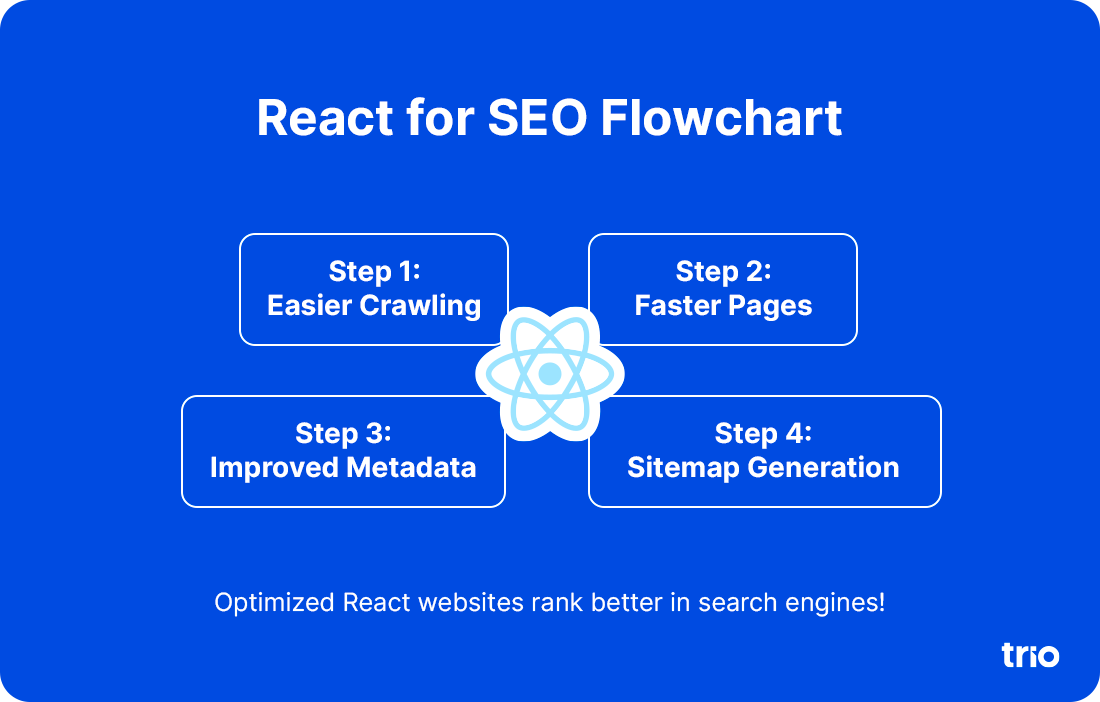Why You Should Use React for Web Development
Hi there! Welcome back to this week’s edition of Trio Insight. Did you know that React is trusted by over 40% of developers? Let’s jump straight into why this JavaScript library might be the right option if you are looking for speed and scalability.
We’ll also cover some of the different areas of your website where React can truly shine and go deeper into why it might just be the right choice for you when it comes to SEO!
React is used in one way or another in just under 5% of all websites out there. The library is great for building quickly and building scalably.
Here’s why many people love React:
💡It’s easy to use! With intuitive, simple components, it’s easy to learn from scratch, so your developers can build powerful applications quickly. A junior developer can probably create interactive UI components after only a few hours.
🔄The reusable components are also very efficient. Your developers write the blocks once and can reuse the code later. We’ve seen this a lot in multi-page components like navigation bars! This also minimizes mistakes.
🚀The virtual DOM is a big advantage of React as it means your web apps will be faster and more responsive. Faster updates also mean you’ll be able to handle real-time user interactions, giving you access to things like live chat or dynamic dashboards.
🌎Then, there’s the strong community! Since so many people use React, there are a lot of people to help when you run into issues, and it should be fairly easy to find developers with React experience.
This is really just scraping the surface, though. If you are looking for a library to help you build your web app, check out our full article on React to figure out if it is the best option for you.
Knowing what’s going on in the world is essential when you’re creating web and mobile apps. Keeping tabs on the latest industry news helps you stay innovative and competitive. Let’s look at what’s going on this week.
The Linux Foundation has a new initiative for Chromium browsers. This means we’re in for more stability and innovation when it comes to web development tools.
React developers can expect smoother browser compatibility and more powerful tools for robust testing thanks to this new initiative.
TuxCare has also announced more .NET 6 support. With Microsoft ending lifecycle support, this means you can breathe for a little, knowing you’ll still get some of the most critical updates if your apps rely on .NET 6.
If your React developers are using .NET 6 for backend APIs, this support ensures you can maintain security while planning your transition to alternatives.
We all know the pain of working hard on your website only to get no organic traffic. Luckily, you can optimize React websites for SEO with relative ease.
This is largely done by allowing for easier crawling and promoting faster pages. However, React also improves metadata by rendering all client-side content and can generate sitemaps with additional tools.
To make your React site SEO-friendly, we recommend that you start by implementing server-side rendering (SSR) or static site generation (SSG) to ensure all content is easily crawlable. Tools like Next.js make this process simpler and more efficient.
We would also recommend that you check out tools like React Helmet for metadata management and Sitemap.js to ensure search engines can index your site efficiently.
Overall, an experienced React developer will ensure that you make the most of the library and don’t accidentally hinder your ranking.
Wrap-up
React might just be the game-changer that you’ve been looking for in your web development.
If you’ve found the information in this week’s insight useful, share it with a colleague or friend who might benefit from it!
Questions or anything to add? Hit reply! We’re eager to hear from you.
Until next time - keep developing!
Daniel
The Trio Team







